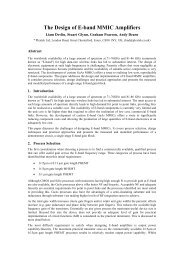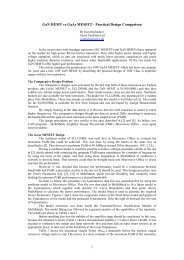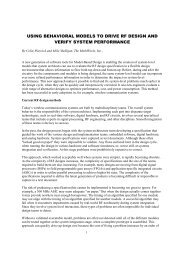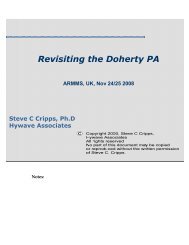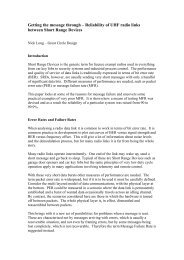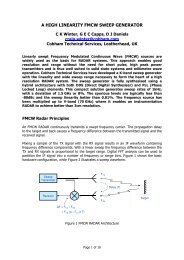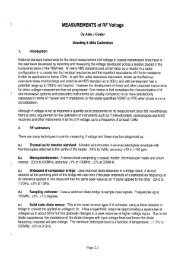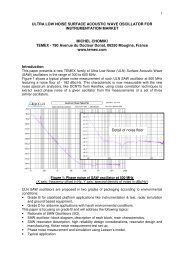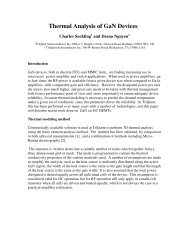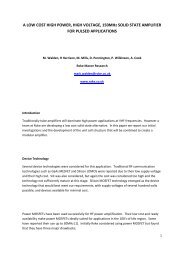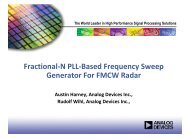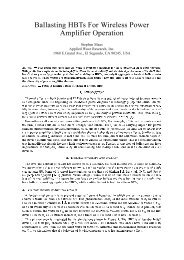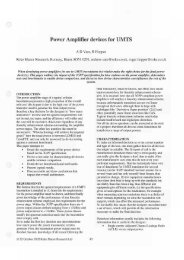Quartzlock Model A7-MX Close-in Phase Noise Measurement ...
Quartzlock Model A7-MX Close-in Phase Noise Measurement ...
Quartzlock Model A7-MX Close-in Phase Noise Measurement ...
You also want an ePaper? Increase the reach of your titles
YUMPU automatically turns print PDFs into web optimized ePapers that Google loves.
<strong>Quartzlock</strong> <strong>Model</strong> <strong>A7</strong>-<strong>MX</strong> <strong>Close</strong>-<strong>in</strong> <strong>Phase</strong> <strong>Noise</strong> <strong>Measurement</strong> & Ultra Low<strong>Noise</strong> Allan Variance, <strong>Phase</strong>/Frequency Comparison<strong>Measurement</strong> of RF & Microwave SourcesCosmo Little and Clive Green<strong>Quartzlock</strong> (UK) Ltd, Gothic, Plymouth Road, Totnes, Devon, TG9 5LH, UK.Tel: +44 1803 862062cgreen@quartzlock.comwww.quartzlock.comSCOPEThis presentation describes the measurement of time doma<strong>in</strong> stability of microwave and RFsources and passive devices between 20MHz and 40GHz. An outl<strong>in</strong>e of a suitablemeasurement <strong>in</strong>strument is proposed.INTRODUCTIONThe <strong>A7</strong><strong>MX</strong> frequency/phase difference comparator is a <strong>Quartzlock</strong> product for measur<strong>in</strong>g a widerange of frequency standards, isolation amplifiers, frequency multipliers and dividers, andpassive devices such as cables. The frequency reference can be either 5MHz or 10MHz.The high resolution <strong>in</strong>put operates on 5MHz or 10MHz with only a small deviation from thenom<strong>in</strong>al frequency be<strong>in</strong>g permitted. The time resolution on the high resolution <strong>in</strong>put is 0.125fs.The actual achievable resolution is noise limited.The high resolution <strong>in</strong>put is <strong>in</strong>tended for the measurement of frequency standards and atomicclocks with outputs of either 5MHz or 10MHz.The low resolution <strong>in</strong>put operates between 50kHz and 65MHz with a basic time resolution of12.5ps. This <strong>in</strong>put cannot give an Allen variance noise floor lower than 3E-11 at tau=1seconddue to the resolution limit.There are three possibilities for extend<strong>in</strong>g the <strong>in</strong>struments frequency range to the high RF andmicrowave doma<strong>in</strong>s. These are:a) Construct a high resolution downconvertor which converts the <strong>in</strong>put frequency to10MHz for <strong>in</strong>put to the high resolution <strong>in</strong>put of the <strong>A7</strong><strong>MX</strong>. Because of the narrow band offrequencies the high resolution <strong>in</strong>put will accept, the downconvertor local oscillator (LO) wouldhave to have 0.01Hz resolution . This is extremely difficult to do.b) Construct a low resolution downconvertor which converts the <strong>in</strong>put frequency toan IF <strong>in</strong> the range 10MHz to 65MHz for <strong>in</strong>put to the low resolution <strong>in</strong>put of the <strong>A7</strong><strong>MX</strong>. The stepsize of the LO can then be equal to the IF bandwidth, ie for LO synthesizer steps of 10MHz, theIF bandwidth would be 10MHz. There is plenty of room <strong>in</strong> the FXQ measurement range toaccommodate the IF bandwidth. The disadvantage of this approach is that it is difficult to
provide a range of measurement bandwidths, important for gett<strong>in</strong>g the best possible timeresolution.c) Construct a high resolution downconvertor us<strong>in</strong>g double conversion. The first IFwould be <strong>in</strong> the range 15 to 25MHz. The first LO would only need 10MHz steps as <strong>in</strong> approach(b). The second LO would tune over the range 15 to 25MHz and would have a high resolution ofsub 1Hz. The f<strong>in</strong>al IF could be 100kHz. At this frequency filter<strong>in</strong>g is much easier, and <strong>in</strong> fact theFXQ could provide the narrow measurement filters . This has already been proposed for the<strong>A7</strong>000. (lower cost version of the <strong>A7</strong><strong>MX</strong>)The general problem with downconvertors is that noise and phase <strong>in</strong>stabilities <strong>in</strong> the LO are<strong>in</strong>dist<strong>in</strong>guishable from noise and phase <strong>in</strong>stabilities on the measured signal. Thus the LOsynthesizer needs impeccable performance, both as regards phase noise and Allen variancenoise floor. The Allen variance noise floor at taus greater than 10seconds will be largelydeterm<strong>in</strong>ed by phase variations due to temperature gradients . Between 0.1 and 10 secondsthere will be a contribution from both temperature <strong>in</strong>stabilities and phase noise. Below 0.1seconds the LO phase noise will dom<strong>in</strong>ate.COMPARISON WITH OTHER INSTRUMENTSBefore decid<strong>in</strong>g on an ideal specification of a microwave phase and frequency measur<strong>in</strong>g<strong>in</strong>strument, it would be useful to consider different types of compet<strong>in</strong>g <strong>in</strong>struments.a) Frequency countersThere are many types of frequency counter, however what is common to all <strong>in</strong>struments <strong>in</strong> thiscategory is that they make time measurements of the zero cross<strong>in</strong>g of the signal to bemeasured. An older generation reciprocal counter will make two measurements of the zerocross<strong>in</strong>gs, at the start and end of the gate period. By also count<strong>in</strong>g the number of zerocross<strong>in</strong>gs between time tags, the frequency can be calculated. The total phase advancebetween time tags can also be calculated. The time resolution cannot be better than that of as<strong>in</strong>gle time tag. This is typically 80ps to 1ns .More modern counters make multiple time tag measurements dur<strong>in</strong>g the gate period, at a rateup to 250ks/s. The <strong>in</strong>termediate time tags can be used to improve the resolution by root(N),where N is the number of measurements available.Some counters such as the most advanced made by Pendulum can store and output a largenumber of time tags for external process<strong>in</strong>g. External process<strong>in</strong>g can identify and measurephase modulation on the orig<strong>in</strong>al signal, and can calculate Allen variance.Counters can be extended to microwave signals by either downconvert<strong>in</strong>g or prescal<strong>in</strong>g.Prescalers are now available up 20GHz. Downconvert<strong>in</strong>g us<strong>in</strong>g a sampl<strong>in</strong>g mixer is morecomplicated, but can extend the frequency up to 50GHz. The advantage of the downconversionapproach is that the basic time resolution of the counter is improved by the ratio of the <strong>in</strong>putfrequency to the IF frequency that is measured. A prescaler does not affect the time resolution.Counters are almost never specified <strong>in</strong> terms of Allen variance noise floor (phase stability) orlong term drift. Resolution is usually specified, and is dom<strong>in</strong>ated by trigger noise, as the <strong>in</strong>putbandwidth is very wide. For this reason counters can never achieve the lowest Allen variance
noise floors.Counters are usually dual channel. They can make time difference measurements between thechannels with one channel act<strong>in</strong>g as the start gate, and the other the stop gate. By us<strong>in</strong>g as<strong>in</strong>gle source with a power splitter, time doma<strong>in</strong> stability of passive devices such as amplifierscan be measured by plac<strong>in</strong>g the device <strong>in</strong> the path between one output of the power splitter andthe counter channel. The resolution of this technique is limited to the basic time resolution of thecounter.b) Modulation doma<strong>in</strong> analysersModulation doma<strong>in</strong> analysers are frequency counters with very rapid measurement rates, and adeep measurement memory. <strong>Measurement</strong> rates go up to 80Ms/s. The frequency resolution<strong>in</strong>versely depends on the measurement rate ( reciprocal of gate time). The s<strong>in</strong>gle shot timeresolution is usually around 100ps.Modulation doma<strong>in</strong> analysers are useful for measur<strong>in</strong>g phase/frequency modulation and drift onCW or pulsed sources. because of their rapid measurement rate, they can measure very shortpulses used <strong>in</strong> pulse compression radar.c) Signal source analysersThese <strong>in</strong>struments are quite new, and comb<strong>in</strong>e a number of measurement types <strong>in</strong>to one<strong>in</strong>strument. They basically work by downconvert<strong>in</strong>g the <strong>in</strong>put signal to either baseband or alower IF. This is then sampled by a high rate ADC (250Ms/s). A digital phase or frequency lockloop is used to lock the LO at the correct frequency.They usually have 2 channels, each with its own reference oscillator and synthesised LO. Bymak<strong>in</strong>g cross correlation measurements between the channels, the reference and LO noise canbe elim<strong>in</strong>ated leav<strong>in</strong>g only the noise from the source. This enables quite low phase noise floorsirrespective of the reference noise.They can also make rapid frequency measurements and can replace modulation doma<strong>in</strong>analysers. In fact Agilent have now discont<strong>in</strong>ued all their modulation doma<strong>in</strong> analysers. Thefrequency resolution is not particularly good, reach<strong>in</strong>g 10-12 for 1 second gate time at 1GHz, butdoes not <strong>in</strong>crease with gate time <strong>in</strong> the usual way. The frequency resolution is a complicatedfunction of the down convertor bandwidth and gate time, for more <strong>in</strong>formation refer to the datasheet for the E5052B.d) Vector network analysersNetwork analysers cannot measure sources, but are very good at measur<strong>in</strong>g phase or groupdelay ( rate of change of phase with frequency, equal to the time delay of the device) <strong>in</strong>amplifiers or other passive devices. Because they have a narrow resolution bandwidth, theyhave very good phase resolution. Typical resolution for differential phase measurements is 0.1degrees, with a temperature stability of 0.2degrees / degC. At 10GHz this is a resolution of 30fs,with a stability of 60fs. A vector network analyser can also measure absolute delay, this iscalled group delay and is calculated from the rate of change of phase over a known frequencysweep. Group delay resolution can be 10ps over 100MHz sweep range.e) Frequency/phase analysersInstruments such as the <strong>A7</strong><strong>MX</strong> are quite rare, and really require their own category. They are
asically counter based <strong>in</strong>struments, but the <strong>in</strong>put signal receives considerable modification,<strong>in</strong>clud<strong>in</strong>g down conversion, before be<strong>in</strong>g measured.Most <strong>in</strong>struments of this type use a dual channel downconvertor with a s<strong>in</strong>gle LO. The mostbasic form measures the phase difference between two signals of the same nom<strong>in</strong>al frequency.In this situation the IF frequencies are the same, and time difference measurements may bemade between the channels us<strong>in</strong>g a frequency counter <strong>in</strong> its time difference mode. The countertime resolution is multiplied by the downconversion ratio (the ratio of the <strong>in</strong>put signal frequencyto the IF frequency). The advantage of the basic form is that to a first approximation the noiseand drift of the LO cancels out.The problem with the basic form is that as the common IF is made lower <strong>in</strong> frequency, with the<strong>in</strong>tention of <strong>in</strong>creas<strong>in</strong>g the time resolution, the available measurement bandwidth gets less. Theother problem is that the phase jitter <strong>in</strong> the required zero cross<strong>in</strong>g detectors <strong>in</strong>creases as theslew rate of the IF decreases. Very narrow bandwidth zero cross<strong>in</strong>g detectors have beendeveloped to avoid this.The <strong>Quartzlock</strong> <strong>A7</strong><strong>MX</strong> actually has two downconversions and two PLL multipliers <strong>in</strong> eachchannel <strong>in</strong> order to get the required time resolution multiplication without the f<strong>in</strong>al IF becom<strong>in</strong>gtoo low <strong>in</strong> frequency. The multiplication is either 103 or 105, with a f<strong>in</strong>al IF of 100kHz. Thechannels are subtracted to remove noise on the common LO us<strong>in</strong>g an offset mix<strong>in</strong>g schemebefore the frequency counter, so only a s<strong>in</strong>gle channel counter is required.Extension of the basic <strong>in</strong>strument to measurement of an <strong>in</strong>put frequency substantially differentfrom the reference frequency means that the downconversion LO must be different for the twochannnels. This immediately means that the condition for cancellation of the LO phase jitter anddrift is lost. The characteristics of the LO will be measured as well as the <strong>in</strong>put signal.If one exam<strong>in</strong>es the block diagram of the Picotime, for example, one can see that it isessentially a s<strong>in</strong>gle channel downconvertor. The 10MHz reference is used to generate two LOsus<strong>in</strong>g DDS synthesisers which downconvert the <strong>in</strong>put to an IF of 1kHz. (double conversion). Allthe drift and spurii of the LOs will be measured along with the <strong>in</strong>put signal.DISCUSSION OF REQUIREMENTS FOR NEW INSTRUMENTThe proposed microwave frequency and phase analyser will be used for the follow<strong>in</strong>gmeasurement tasks:a) <strong>Measurement</strong> of time doma<strong>in</strong> stability of sources between 10MHz and 20(40) GHz referred toa reference source of 10MHz (s<strong>in</strong>gle channel mode)b) <strong>Measurement</strong> of time doma<strong>in</strong> stability of two identical microwave sources with a relativelysmall frequency offset. (dual channel mode)c) <strong>Measurement</strong> of time doma<strong>in</strong> stability of microwave passive devices ( not sources) (dualchannel mode)For requirement (a) the ma<strong>in</strong> competition is a conventional and relatively low cost microwavecounter. The Pendulum CNT-91 offers a fixed s<strong>in</strong>gle shot time resolution of 50ps, applicable upto 20GHz. It uses prescalers to cover the microwave range, rather than downconvertors, sothere is no improvement <strong>in</strong> resolution at higher frequencies. The frequency resolution claims tobe 12 digits <strong>in</strong> 1sec of measurement time. This is quite a vague specification, but impliesresolution of 1ps after averag<strong>in</strong>g. The counter makes multiple time tag measurements and
improves its resolution by l<strong>in</strong>ear regression of the time tags to obta<strong>in</strong> average frequency dur<strong>in</strong>gthe measurement period.As with all counters, there is no specification on Allen variance noise floor or drift.The basiccounter will show Allen variance at one gate time, but <strong>in</strong> order to produce a graph the countermust be used with a PC and the Timeview software.A new <strong>in</strong>strument based on a downconvertor would certa<strong>in</strong>ly be able to get much betterresolution than 1ps. An <strong>in</strong>strument based on approach (b) above at 10GHz would improve thebasic resolution of the FXQ ( the phase meter used <strong>in</strong> the <strong>A7</strong><strong>MX</strong>) by 500 times, which wouldgive a basic time resolution of 25fs. It is very difficult to estimate the usable noise limitedresolution, however, as this will depend upon the noise performance of the LO.One might question whether there are any free runn<strong>in</strong>g sources to be measured at microwavefrequencies. Most microwave sources are synthesized, <strong>in</strong> which case there is hardly any po<strong>in</strong>t<strong>in</strong> mak<strong>in</strong>g Allen variance measurements at long averag<strong>in</strong>g times as the performance will beequal to the synthesizer reference that is used, and this could be measured us<strong>in</strong>g a standard<strong>A7</strong><strong>MX</strong>.Conceivable microwave measurements us<strong>in</strong>g a 2 channel <strong>in</strong>strument might be the phasestability of cables and other passive ( not sources) devices such as amplifiers, phase shifters,and power splitter/isolation devices. The phase performance of these is important forapplications such as phased array radars. Unfortunately most labs seriously develop<strong>in</strong>gmicrowave devices will have a vector network analyser, and will use this to evaluate phasestability.In s<strong>in</strong>gle channel mode, the <strong>in</strong>strument could measure frequency stability aga<strong>in</strong>st a 10MHzreference. By us<strong>in</strong>g the same sort of averag<strong>in</strong>g techniques as the Pendulum counter ( l<strong>in</strong>earregression of multiple time tags) resolution of 10E-14 <strong>in</strong> one second of gate time could beachieved. The actual Allen variance floor will be determ<strong>in</strong>ed by the stability of the localoscillators.OUTLINE PERFORMANCE OF NEW INSTRUMENTThe proposed <strong>in</strong>strument will have the follow<strong>in</strong>g features:a) Two measurement channels with common local oscillators <strong>in</strong> order to measure identicalfrequency sources and passive devices. In this mode substantial cancellation of the localoscillator noise and drift can be expected.b) A basic measurement range of 10MHz to 2GHzc) An extended measurement range of 2GHz to 20GHZ ( possibly 30GHz)d) <strong>Measurement</strong> bandwidths of 10kHz to 0.1Hz provided by digital filterse) M<strong>in</strong>imum s<strong>in</strong>gle shot phase resolution of 125fs at 10MHz ris<strong>in</strong>g to 0.625fs at 2GHz.f) A user <strong>in</strong>terface similar to the exist<strong>in</strong>g <strong>A7</strong><strong>MX</strong>, with displays of Allen variance and powerspectral density.
OUTLINE OF DETAILED DESIGNIt is not possible to be too explicit about the design details at this moment. The follow<strong>in</strong>gcomments can be made:a) The <strong>in</strong>strument will be double conversion on the basic range and triple conversion on theextended rangeb) On the basic range the first IF will be tunable between 15MHz and 25MHz. The second IF willbe 100kHzc) On the extended range the first IF will be tunable between 1GHz and 2GHz ( tbc)d) In order to achieve the best possible phase stability, the design of the first LO synthesiser,which will cover the range 25MHz to 2GHZ <strong>in</strong> steps of 10MHz, will be optimised for phasestability with temperature and low noise. It is probable that a harmonic lock<strong>in</strong>g loop will be usedwith a sampl<strong>in</strong>g phase detector. This type of loop uses no digital dividers.e) The second LO synthesiser covers the range 15MHz to 25MHz <strong>in</strong> steps of



